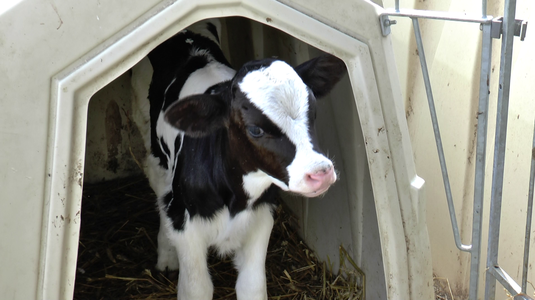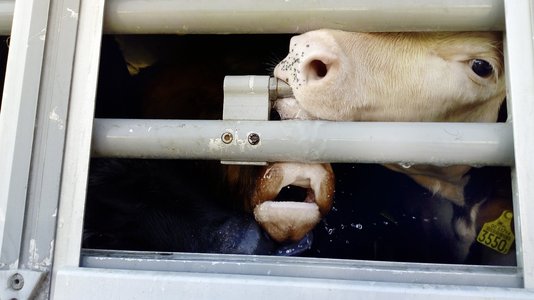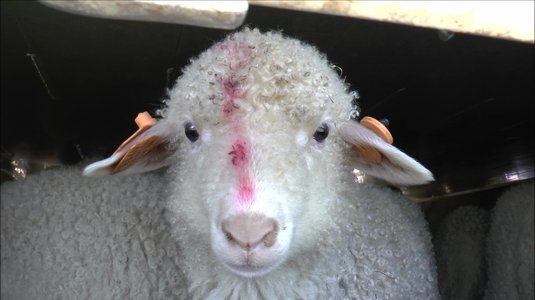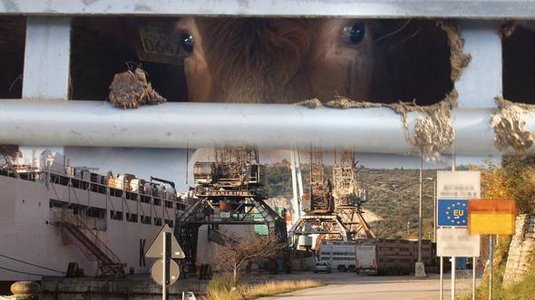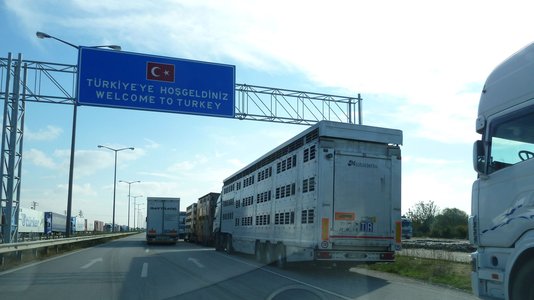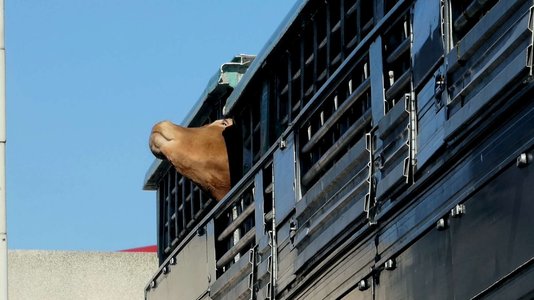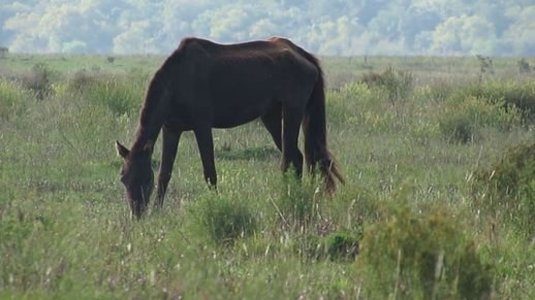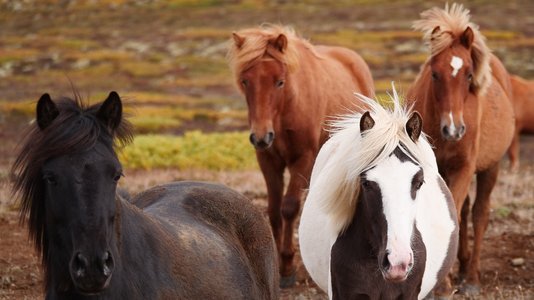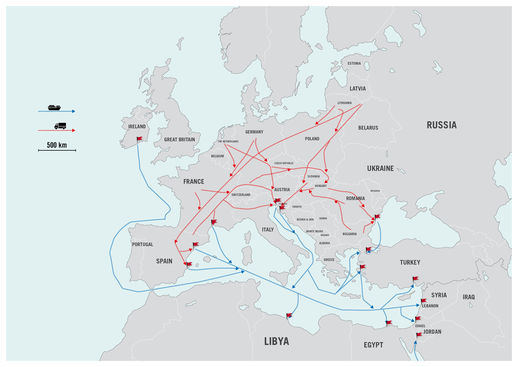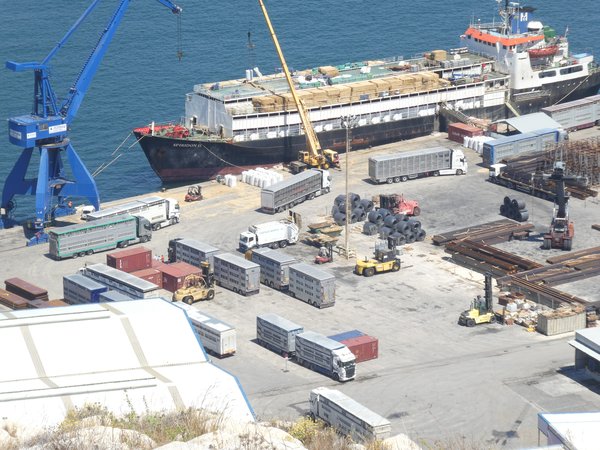Dossiers
Animal Welfare Overboard
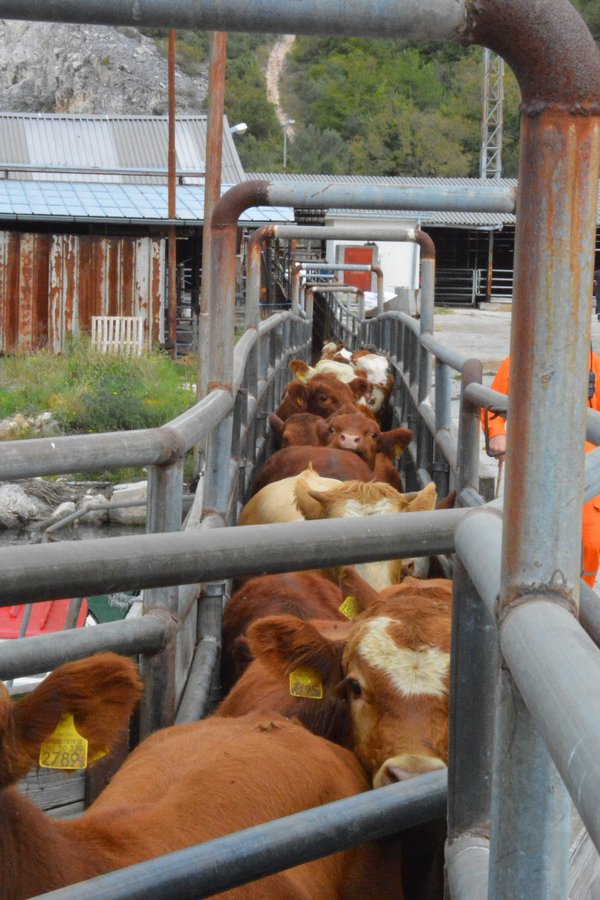
1. The lack of animal protection during sea transport
Each year the European Union exports almost three million sheep and cattle to Turkey, the Middle East and North Africa. This report is about the transportation of these animals by sea and the potential welfare and environmental impacts of this trade.
The main reason for transporting EU animals by sea is the demand for live animals in Third Countries, including so called “breeding” animals, animals for further fattening and for immediate slaughter. Animals are being carried to Third Countries without any consideration as to whether importing countries’ infrastructure, handling and slaughter practices comply with international standards.
Mainly cattle and sheep are transported from different EU Member States with road vehicles to EU ports and further to countries in the Middle East, North Africa, Turkey and Israel. The transport time on the Mediterranean Sea lasts usually between five to eight days, but transports of up to 15 days have been registered during 2016. The main exporting ports are: Sete, France; Rasa, Croatia; Greenore and Waterford, Ireland; Setúbal and Sines, Portugal; Midia, Romania; Koper, Slovenia; and Tarragona and Cartagena, Spain.
The vessels operating in the Mediterranean Sea have an average age of 35 years, most of them sailing under flags with substandard legislation.
During the long journeys by road, sea and subsequent road transport in the country of destination, the animals are exposed to welfare risks such as transport stress, fatigue, environmental (thermal) stress, health implications and injuries. There are no statistics available on the number of EU animals dying, becoming ill or being injured on these voyages. There is no requirement for a veterinarian to accompany animals on board the livestock vessel. This means that sick and injured animals have no access to veterinary care – nor is there any expert oversight or management of disease risks.
Between 2014 and 2017 our teams have been on nine so-called “Walk-on-walk-off” vessels prior or during the loading of animals. We also had the chance to observe the conditions on a vessel during a sea journey from Europe to Egypt.
2. International maritime conventions
AMSA: Australian Maritime Safety Authority that provides in its Maritime Order 43 minimum provisions for the construction of vessels and transport of animals.
IMO: The International Maritime Organization is the United Nations specialized agency with responsibility for the safety and security of shipping and the prevention of marine pollution by ships. IMO is the global standard-setting authority for the safety, security and environmental performance of international shipping. Its main role is to create a regulatory framework for the shipping industry that is fair and effective, universally adopted and universally implemented. (Source: www.imo.org) For ships, the IMO number, which is a unique reference to the ship, remains linked to the hull for its lifetime, regardless of a change in name, flag, or owner. (Source: Wikipedia)
EMSA: The European Maritime Safety Agency (EMSA) is a European Union agency charged with reducing the risk of maritime accidents, marine pollution from ships and the loss of human lives at sea by helping to enforce the pertinent EU legislation. It is headquartered in Lisbon.
Flag of Convenience (FOC): FOC is a business practice whereby a ship is registered in a country other than that of the ship's owners. Owners of a ship may register the ship under a flag of convenience to reduce operating costs or avoid the regulations of the owner's country. Flag-of convenience registries are criticized, mostly by trade union organizations based in developed countries, especially those of Europe. A basis for many criticisms is that the flag-of-convenience system allows ship owners to be legally anonymous and difficult to prosecute in civil and criminal actions. Some ships with flags of convenience have been found engaging in crime, offer substandard working conditions, and negatively impact the environment.(Source: Wikipedia)
Paris MoU: The organization consists of 27 participating maritime Administrations and covers the waters of the European coastal States and the North Atlantic basin from North America to Europe, with the mission to eliminate the operation of sub-standard ships through a harmonized system of port State control. The Paris MoU Committee approved a quality performance lists of Flag States, where 11 flags of convenience are targeted for special enforcement by countries that they visit (black-grey-white list of flags).
Flag State: The flag state of a commercial vessel is the state under whose laws the vessel is registered or licensed. The flag state has the authority and responsibility to enforce regulations over vessels registered under its flag, including those relating to inspection, certification, and issuance of safety and pollution prevention documents. As a ship operates under the laws of its flag state, these laws are applicable if the ship is involved in an admiralty case. Quelle: www.parismou.org)
Classification Societies: Classification societies set the technical rules for ships, confirm that designs and calculations meet these rules, survey ships during the process of construction and commissioning, and periodically survey vessels to ensure that they continue to meet the rules.
IACS: The International Association of Classification Societies is a technically based organization consisting of twelve marine Classification Societies, committed to a unique contribution to maritime safety and regulation through technical support and compliance verification.
MARPOL 73/78 is the International Convention for the Prevention of Pollution from Ships, 1973 as modified by the Protocol of 1978, Annex VI and V. All ships flagged under countries thatare signatories to MARPOL are subject to its requirements, regardless of where they sail and member nations are responsible for vessels registered under their respective nationalities (Wikipedia).
The International Convention for the Safety of Life at Sea (SOLAS) is an international maritime treaty which requires signatory flag states to ensure that ships flagged by them comply with minimum safety standards in construction, equipment and operation. The current version of the SOLAS Convention is SOLAS 1974, which came into force on 25 May 1980.
International Convention on Load Lines: In accordance with the International Convention on Load Lines all assigned load lines must be marked amidships on each side of the ships engaged in international voyages. The determinations of the freeboard of ships are calculated and/orverified by the Classification Societies which issue International Load Line Certificates inaccordance with the legislation of participating States.
Treaty on the Functioning of the European Union (TFUE)
The TFUE stipulates that the EU Member States shall observe the welfare of animals. There is a special provision in this respect (Article 13) stipulating as follows: “In formulating and implementing the Union's agriculture, fisheries, transport, internal market, research and technological development and space policies, the Union and the Member States shall, since animals are sentient beings, payfull regard to the welfare requirements of animals, while respecting the legislative or administrative provisions and customs of the Member States relating in particular to religious rites, cultural traditions and regional heritage.” The imperative provisions of the Treaty stipulate that all Member States shall pay full regard to the lifetime welfare of animals without exception, which therefore undoubtedly includes animals transported to slaughterhouses, because the EU policy is to treat animals as sentient beings regardless of the fact that they are intended for slaughter.
3. Council Regulation (EC) 1/2005
The Council Regulation (EC) No 1/2005 covers all commercial transports of EU animals, including transport by sea. The core demand of the Regulation is article 3 that stipulates that “No person shall transport animals or cause animals to be transported in away likely to cause injury or undue suffering to them“ Specific to transport by sea are only Article 19 and 20 in connection with some detailed requirements in the Annex. Article 19 deals with the approval of the livestock vessel and Article 20 regulates the inspection of livestock vessel, fitness for transport of the animals, handling of the animals and feeding/ watering arrangements on the vessel.
The “Network document on livestock vessels”
Therefore, the EU Commission initiated in 2014 the so-called “Network document on livestock vessels” with a group of experts, produced as a Guidance for vessel inspections and operation. The key points of this document are:
- Approval of livestock vessels
- Loading inspections
- Communication between Member States on the results above.
4. EU-approved vessels for the sea transport of animals
The fleet carrying animals from EU ports has an average age of 35 years. In ship Risk Profiles ships over 12 years are automatically in a higher risk level 5. In comparison, merchant ships are often scrapped long before the age of 20 years, because of the increasing risks of mechanical and structural failure. Beside mechanical breakdowns on these livestock vessels, there can be a failure of the ventilationsystem or the water delivery.
Only 24% of the listed vessels are f lagged under the “white list ”, represent ing so-called quality flags. The majority of vessels, 54%, are licensed in flag states like Tanzania, Modova, Cambodia, Sierra Leone and Togo, all ranked on the black list for flag states with poor performance that are considered high or very high risk. 22% of the vessels are under flag states ranked on the grey list of the Paris Memorandum 2015.
78% of the listed vessels are classified by Classification Societies, who are not members of IACS and have presumably low standards.
5. Animal welfare concerns during loading procedures
Vessels are always loaded as fast as possible, because “time is money”. The handlers and drivers were often seen poking and prodding through the open bars of the truck to force the animals to leave the truck.
Once on the gangway ramp, the animals are constantly pushed to continue. Depending on the loading facilities and the vessel’s entry, the animals either walk easily onto the vessel, or they balk. If the animal in the front of the line is afraid of entering the vessel and moves backward, problems on the ramp often start. Animal handlers were observed poking and prodding the animals. The animal in the back of the line wants to move forward to escape the rough handlers behind. We observed cattle in the middle of the raceway fall down and get trampled by the ones in the front and back, adding to the fear and chaos in the raceway. Such stress during loading will lead to very poor welfare.
The entry of the vessels often appears like a black hole for the animals, especially during loading in bright daylight. We observed that the animals often balked in front of the vessel entry, because they refuse to walk from light into dark areas. The ships may also be pressurized from the supply ventilation escaping through the loading doors on closed deck ship. This exhaust/wind can be strong and an additional cause for the animals to balk.
Jamming in the gangway is a very dangerous situation for the animals and the handlers, because animals might turn around or jump from the gangway. Thus the handlers are constantly pushing the animals with electrical prodders to make them move onwards. Often the last animals are prodded intensively to make them push the animals ahead of them, leading to severe stress in some of them. We observed a bull stuck in between the others who could not move, but a driver was constantly prodding him. We observed him panting, roaring and breathing with a wide-open mouth.
Many animals struggled or even fell down when the ramp exceeded the inclination of 26 degrees. The loading facilities may have several distracting details that cause stress to the animals, such as shadows, or cranes loading hay and straw onto the vessel. Due to the loading facilities in the Port the loading ramp onto the vessel can be very steep, depending on the vessel and the tide.
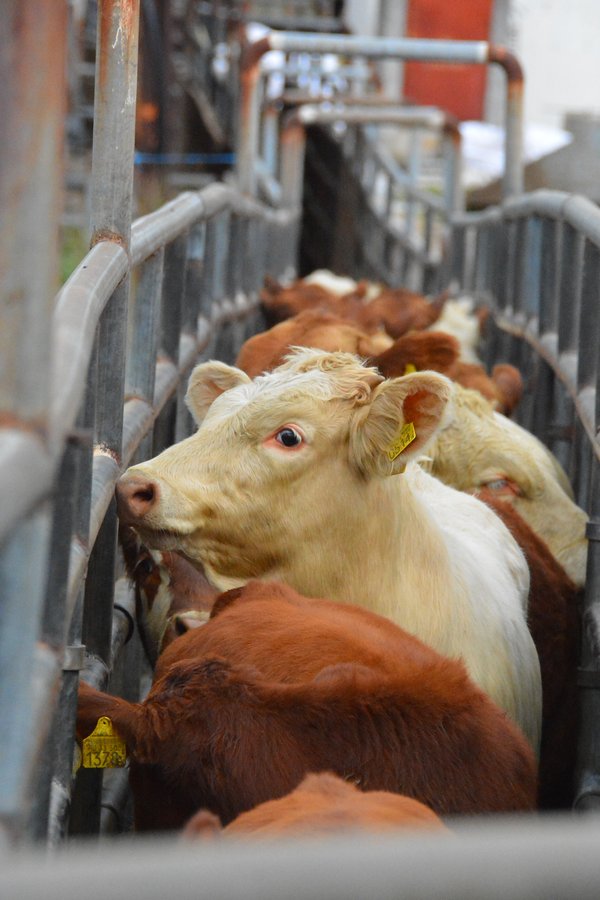
6. Animals are not properly inspected for their fitness for transport
Due to the fact that the majority of animals are not rested for 24 hours in the ports, there is no time for a proper inspection for fitness for transport. Especially when the animals are loaded directly from the road vehicle onto the vessel, which is the procedure in most of the ports, there is no possibility for a thorough inspection of the animals. With this procedure it is in our opinion impossible for a veterinarian to properly check the animals for fitness and diseases as they walk by. This is especially difficult if the veterinarian/ inspector can only see one side of the animal, and if the animals are moving quickly.
We urge the European Commission to stop the export of live animals
The full dossier on live exports by sea consists of 79 pages.
On request, the full dossier can be made available to competent authorities, veterinarians and media representatives.
